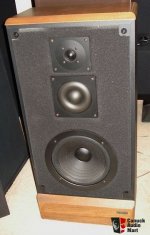I cannot agree with this statement in general. As I have shown, you can design a baffle to work best under a single angle and this angle can be whatever you like. It can also be straight in front of the speaker.
The statement holds true, however, for symmetrical speakers since in this case the diffractions due to the left edge and the right edge overlap. Tilting the speaker will seperate the diffraction pattern so that they will partly compensate each other. According to the pictures in the link you provided the cabinets in question seem to be symmetrical.
The same can be said regarding the 30° rule of thumb. If a speaker is designed to give the least deviation at 0° then the 30° rule of thumb doesnt apply.
As I have shown, you can design a baffle to work best under a single angle and this angle can be whatever you like. It can also be straight in front of the speaker.
I do not reject this statement. I do believe that You can indeed
BUT You need more than the optimized baffle shape*
If a speaker is designed to give the least deviation at 0° then the 30° rule of thumb doesnt apply.
Yes, "IF"
Last edited:
* because: https://www.diyaudio.com/forums/mul...esign-improve-diffraction-40.html#post5181894
therefore You need a special speaker driver too: https://www.diyaudio.com/forums/mul...esign-improve-diffraction-40.html#post5181935
therefore You need a special speaker driver too: https://www.diyaudio.com/forums/mul...esign-improve-diffraction-40.html#post5181935
Do like Advent did with my floorstanding Maestro speakers....
A 1/2 inch layer of foam across the whole face of the front baffle - tames any reflections nicely.
No need for any of that sillyness and obsessive plundering.
A 1/2 inch layer of foam across the whole face of the front baffle - tames any reflections nicely.
No need for any of that sillyness and obsessive plundering.
Attachments
Last edited:
